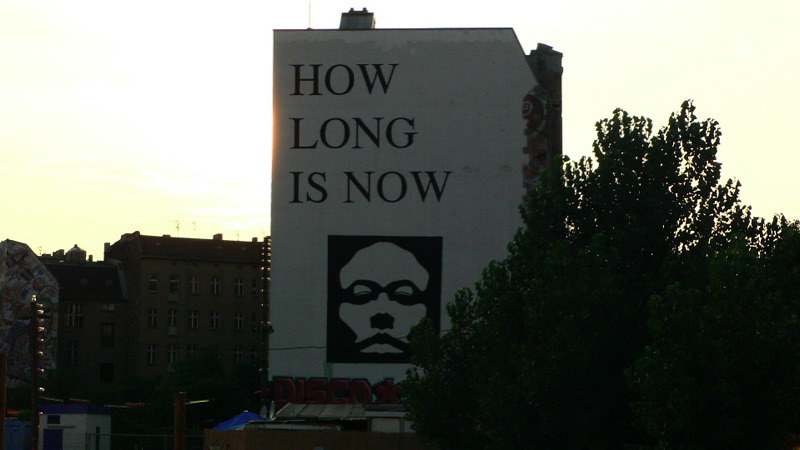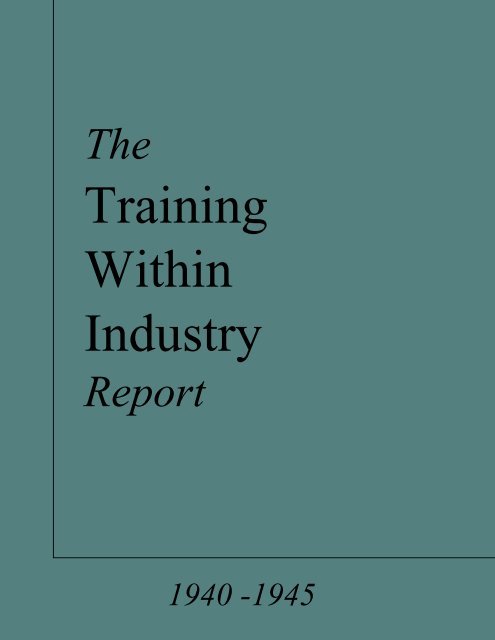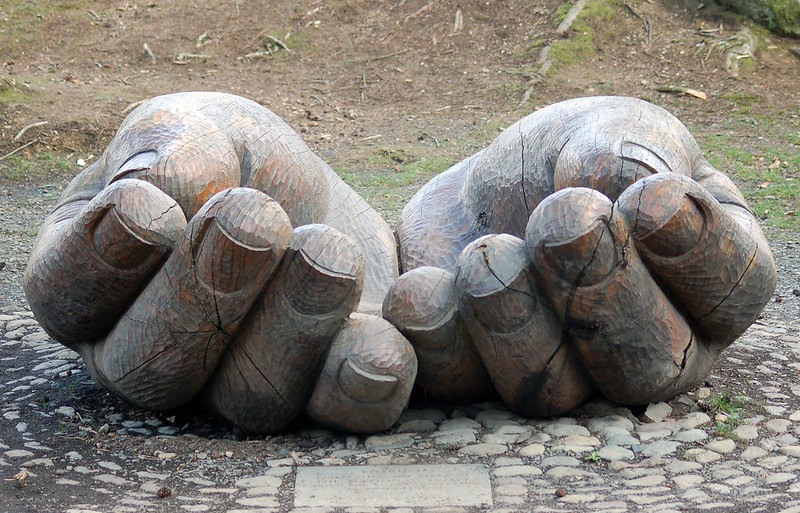Archive for the ‘The Future’ Category
Success Strangles
 Success demands people do what they did last time.
Success demands people do what they did last time.
Success blocks fun.
Success walls off all things new.
Success has a half-life that is shortened by doubling down.
Success eats novelty for breakfast.
Success wants to scale, even when it’s time to obsolete itself.
Success doesn’t get caught from behind, it gets disrupted from the bottom.
Success fuels the Innovator’s Dilemma.
Success has a short attention span.
Success scuttles things that could reinvent the industry.
Success frustrates those who know it’s impermanent.
Success breeds standard work.
Success creates fear around making mistakes.
Success loves a best practice, even after it has matured into bad practice.
Success doesn’t like people with new ideas.
Success strangles.
Success breeds success, right up until the wheels fall off.
Success is the antidote to success.
“20204-roots strangle bricks” by oliver.dodd is licensed under CC BY 2.0
Why not now?
 If you are anxious, you’re worried about what might happen. You’re living in the future. If you are sad or angry, you’re reacting to what happened. You’re living in the past. Nothing can be accomplished when living in the past because the die is cast. And nothing can be accomplished when living in the future because it’s all in your head. The only time we have is now.
If you are anxious, you’re worried about what might happen. You’re living in the future. If you are sad or angry, you’re reacting to what happened. You’re living in the past. Nothing can be accomplished when living in the past because the die is cast. And nothing can be accomplished when living in the future because it’s all in your head. The only time we have is now.
The only time to start is now. Even if your project is a short one, you’re in a day-for-day slip with your completion date for every day you don’t start. And this is doubly true for long projects. If you’re living in the past, you block yourself from starting because the last project was difficult, you didn’t have the resources or it didn’t come out as expected, and you want to protect yourself from a rerun. If you’re living in the past, you block yourself from starting because you don’t know how it will turn out, you don’t have all the answers, you don’t have sufficient resources, and you don’t know what you don’t know. Acknowledge the problems with the past and potential problems with the future, and start anyway.
Starting starts with starting.
The only time to say something is now. If you’re living in the past, you block yourself from saying something controversial or thought-provoking because you remember how it went the last time someone did that. If you’re living in the future, you prevent yourself from saying something radical because, well, you weren’t paying attention and missed your opportunity to change history. Acknowledge that there may be some blowback for your insightful comments, live in the now and say them anyway. And live in the now so you can pay attention and use your sharp wit to create the future.
If you don’t say something, nothing is ever said.
The only time to help is now. Living in the past, you block yourself from understanding the significance of the situation because you see it through old lenses. Living in the future, you block yourself from helping because you worry if the helping will help or worry the helping will get in the way of your future commitments. If someone needs help, help them now. They will understand that the outcome is uncertain, and they’re okay with that. In fact, they will be happy you recognized their troubling situation and made time to check in with them. When you live in the now, people appreciate it. The time to help is now.
When no one helps, no one is helped.
When you find yourself living in the past, close your eyes, recognize your anger or sadness, and focus on your breath for ten seconds. And if that doesn’t work, put your hand on your chest and do it again. And if that doesn’t work, tell yourself your sadness is temporary and do it again. This is a fail-safe way to bring yourself into the now. Then, sitting in the now, start that project, say what must be said, and help people.
And when you find yourself living in the future, close your eyes, recognize your anxiety, and focus on your breath for ten seconds. And if that doesn’t work, put your hand on your chest and do it again. And if that doesn’t work, tell yourself your anxiety is temporary and repeat. This will bring you into the now. Then, sitting in the now, start that project, say what must be said, and help people.
The only time to shape the future is now.
“HOW LONG IS NOW” by dr. motte is licensed under CC BY 2.0
The Discomfort Around Diversity of Perspective
 When your organization doesn’t want to hear your truth because it contradicts a decision they’ve already made, that’s a sign of trouble. It’s a sign they’re going to do what they’re going to and they don’t care all that much about you. But, what if they’re wrong? And what if your perspective could snatch victory from the flames of an impending train wreck? As someone who cares about the company and thinks it would benefit from hearing what you have to say, what do you do?
When your organization doesn’t want to hear your truth because it contradicts a decision they’ve already made, that’s a sign of trouble. It’s a sign they’re going to do what they’re going to and they don’t care all that much about you. But, what if they’re wrong? And what if your perspective could snatch victory from the flames of an impending train wreck? As someone who cares about the company and thinks it would benefit from hearing what you have to say, what do you do?
When you have a culture that makes it clear it’s not okay to share divergent perspectives, you have a big problem.
In domains of high uncertainty, increasing the diversity of perspective is the single most important thing we can do to see things more clearly. In these situations, what matters is the diversity of culture, of heritage, of education, of upbringing, and of experiences. What matters is the diversity of perspective; what matters is the level of divergence among the collective opinions, and what matters most is listening and validating all that diversity.
If you have the diversity of culture, heritage, education, and experience, congratulations. But, if you’re not willing to listen to what that diversity has to say, you’re better off not having it. It’s far less expensive if you don’t have it and far fewer people will be angry when you don’t listen to them. But, there’s a downside – you’ll go out of business sooner.
When you have a perspective that’s different than the Collective’s, share it. And when there are negative consequences for sharing it, accept them. And, rinse and repeat until you get promoted or fired.
“A Sense of Perspective” by dolbinator1000 is licensed under CC BY 2.0
What should we do next?
 Anonymous: What do you think we should do next?
Anonymous: What do you think we should do next?
Me: It depends. How did you get here?
Anonymous: Well, we’ve had great success improving on what we did last time.
Me: Well, then you’ll likely do that again.
Anonymous: Do you think we’ll be successful this time?
Me: It depends. If the performance/goodness has been flat over your last offerings, then no. When performance has been constant over the last several offerings it means your technology is mature and it’s time for a new one. Has performance been flat over the years?
Anon: Yes, but we’ve been successful with our tried-and-true recipe and the idea of creating a new technology is risky.
Me: All things have a half-life, including successful business models and long-in-the-tooth technologies, and your success has blinded you to the fact that yours are on life support. Developing a new technology isn’t risky. What’s risk is grasping tightly to a business model that’s out of gas.
Anon: That’s harsh.
Me: I prefer “truthful.”
Anon: So, we should start from scratch and create something altogether new?
Me: Heavens no. That would be a disaster. Figure out which elements are blocking new functionality and reinvent those. Hint: look for the system elements that haven’t changed in a dog’s age and that are shared by all your competitors.
Anon: So, I only have to reinvent several elements?
Me: Yes, but probably fewer than several. Probably just one.
Anon: What if we don’t do that?
Me: Over the next five years, you’ll be successful. And then in year six, the wheels will fall off.
Anon: Are you sure?
Me: No, they could fall off sooner.
Anon: How do you know it will go down like that?
Me: I’ve studied systems and technologies for more than three decades and I’ve made a lot of mistakes. Have you heard of The Voice of Technology?
Anon: No.
Me: Well, take a bite of this – The Voice of Technology. Kevin Kelly has talked about this stuff at great length. Have you read him?
Anon: No.
Me: Here’s a beauty from Kevin – What Technology Wants. How about S-curves?
Anon: Nope.
Me: Here’s a little primer – Beyond Dead Reckoning. How about Technology Forecasting?
Anon: Hmm. I don’t think so.
Me: Here’s something from Victor Fey, my teacher. He worked with Altshuller, the creator of TRIZ – Guided Technology Evolution. I’ve used this method to predict several industry-changing technologies.
Anon: Yikes! There’s a lot here. I’m overwhelmed.
Me: That’s good! Overwhelmed is a sign you realize there’s a lot you don’t know. You could be ready to become a student of the game.
Anon: But where do I start?
Me: I’d start Wardley Maps for situation analysis and LEANSTACK to figure out if customers will pay for your new offering.
Anon: With those two I’m good to go?
Me: Hell no!
Anon: What do you mean?
Me: There’s a whole body of work to learn about. Then you’ve got to build the organization, create the right mindset, select the right projects, train on the right tools, and run the projects.
Anon: That sounds like a lot of work.
Me: Well, you can always do what you did last time. END.
“he went that way matey” by jim.gifford is licensed under CC BY-SA 2.0
How will you allocate your time differently?
I don’t like resolutions, but I do like looking back to assess how spent my time differently over the previous year. Below is a short exercise that could help you get ready for 2021.
Below are some questions intended to help you assess how you spent your time differently in 2020. Take fifteen seconds, or so, to think through each one.
Did you spend more time with your family or less?
Did you spend more time helping yourself or others?
Instead of commuting, what did you do with your time?
Did you work more hours or fewer?
Did you spend more time on your mental/spiritual health or less?
Did you take more vacation days or fewer?
Instead of eating out, what did you do with that time?
Did you exercise more or less?
What did you do with your time freed by reduced business travel do more?
Did you participate in more meetings or fewer?
Did you sleep more or less?
Grab a pen and paper (or print out the text below) and let’s go through the rest of the exercise.
What are the top three questions that caused the strongest emotional response? (Write them down.) For those three questions, think through three scenarios: A) 2021 is just like 2020. B) 2021 amplifies the changes you experienced in 2020. C) 2021 is just like 2019.
For each scenario, write down how you’d allocate your time differently in 2021.
The question that caused the strongest emotional response:
_________________________________________________________________________
With regard to the question above, how would you allocate your time differently in 2021?
Scenario A (same as 2020) ____________________________________________________
Scenario B (amplified changes) _________________________________________________
Scenario C (same as 2019) ____________________________________________________
The question that caused the second strongest emotional response:
________________________________________________________________________
With regard to the question above, how would you allocate your time differently in 2021?
Scenario A (same as 2020) ___________________________________________________
Scenario B (amplified changes) ________________________________________________
Scenario C (same as 2019) ____________________________________________________
The question that caused the third strongest emotional response:
________________________________________________________________________
With regard to the question above, how would you allocate your time differently in 2021?
Scenario A (same as 2020) __________________________________________________
Scenario B (amplified changes) _______________________________________________
Scenario C (same as 2019) ___________________________________________________
My list of questions likely missed important questions for you. You may want to go back and ask yourself other questions and see if your emotional response is strong enough to displace the top three you identified above.
This little exercise doesn’t generate resolutions, nor will it tell you how to allocate your time in 2021. But, I hope it helps you more skillfully navigate the uncertainty that 2021 is certain to bring.
Happy New Year. And thanks for reading.
“Sundial” by Nigel_Brown is licensed under CC BY 2.0
The Foundation of Leadership Development — Work Products
 Leadership development is a good idea in principle, but not in practice. Assessing a person against a list of seven standard competencies does not a leadership development plan make. Nor does a Meyers-Briggs assessment or a strengths assessment. The best way I know to describe the essence of leadership development is through a series of questions to assess and hire new leaders.
Leadership development is a good idea in principle, but not in practice. Assessing a person against a list of seven standard competencies does not a leadership development plan make. Nor does a Meyers-Briggs assessment or a strengths assessment. The best way I know to describe the essence of leadership development is through a series of questions to assess and hire new leaders.
Here’s the first question: Is this person capable of doing the work required for this leadership position? If you don’t start here, choose the person you like most and promote (or hire) them into the new leadership position. It’s much faster, and at least you’ll get along with them as the wheels fall off.
Next question: In this leadership position, what work products must the leader create (or facilitate the creation of)? Work products are objective evidence that the work has been completed. Examples of work products: analyses, reports, marketing briefs, spreadsheets, strategic plans, product launches, test results for new technologies. Here’s a rule: If you can’t define the required work products, you can’t define the work needed to create them. Here’s another rule: If you can’t define the work, you can’t assess a candidate’s ability to do that work. And if you can’t assess a candidate’s ability to the work, you might as well make it a popularity contest and hire the person who makes the interview committee smile.
Next question: Can the candidate show work products they’ve created that fit with those required for the leadership position? To be clear, if the candidate can show examples of all the flavors of work products required for the position, it’s a lateral move for the candidate. That’s not a bad thing, as there are good reasons candidates seek lateral positions (e.g., geographic move due to family or broadening of experience – new product line or customer segment). And if they’ve demonstrated all the work products, but the scope and/or scale are larger, the new position, the new position is a promotion for the candidate. Here’s a rule: if the candidate can’t show you an example of a specific work product or draw a picture of one on the whiteboard, they’ve never done it before. And another rule: when it comes to work products, if the candidate talks about a work product but can’t show you, it’s because they’ve never created one like that. And talking about work products in the future tense means they’ve never done it. When it comes to work products, there’s no partial credit.
Next question: For the work products the candidate has shown us, are they relevant? A candidate won’t be able to show you work products that are a 100% overlap with those required by the leadership position. The context will be different, the market will be different, and the players will be different. But, a 50-70% overlap should be good enough.
Next question: For the relevant work products the candidate has shown us, do they represent more than half of those required? If yes, go to the next question.
Next question: For the work products the candidate has not demonstrated, has the team done them? If the team has done a majority of them, that’s good. Go to the next question.
Next question: For the work products the candidate or team has not demonstrated, can we partner them with an expert (an internal one, I hope) who has? If yes, hire the candidate.
Leadership development starts with the definition of the new work the leader must be able to do in their next position. And the best way I know to define the work is to compile a collection of work products that must be created in the next position and match that against the collection of work products the leader has created. The difference between the required work products and the ones the leader has demonstrated defines the leadership development plan.
To define the leadership development plan, start with the work products.
And to help the leader develop, think apprenticeship. And for that, see this seminal report from 1945.
The Dark Underbelly of Success
 Best practice – a tired recipe you recycle because you think the world is static.
Best practice – a tired recipe you recycle because you think the world is static.
Emergent practice – a new way to work created from whole cloth because the context is new.
Worst practice – a best practice applied to a world that has changed around you.
Novel practice– work that recognizes the world is a different place but is dismissed out-of-hand because everyone wants to live in the comfortable past.
Continuous improvement – when you try to put a shine on a tired, old process that worked ten years ago.
Discontinuous improvement – work that is disrespectful to the Status Quo and hurts people’s feelings.
Grow the core – when you do what you did in 2010 because you don’t know what else to do.
Obsolete your best work – when you do work that makes it clear to your customers that they should not have purchased your most successful product.
Reduce operating expense – what you do when you don’t know how to grow the top line and want to eliminate the flexibility to respond to an uncertain future.
Grow the top line – when you launch a new product that causes your customers to happily throw away the product they just bought from you.
A PowerPoint slide deck that defines your strategic plan – an electronic work product that distracts you from the reality of an ever-changing future.
A new product that is radically better than your last one – what you should create instead of a PowerPoint slide deck that defines your strategic plan.
MBA – a university degree that gives you a pedigree so companies hire you.
Ph.D. – a university degree that teaches you to learn, but takes too long.
Return On Investment (ROI) – a calculation that scuttles new work that would reinvent your business.
Imagination – thinking that will help you navigate an uncertain future, but is knee-capped by the ROI calculation.
Standard work – a process you used last time and will use next time because, again, you think the world is static.
Judgment – thinking that creates a whole new business trajectory to address an uncertain future but can get you fired if you use it.
A sustainable competitive advantage – a relic of a slow-moving world.
Continual change – the only way to deal with an ever-accelerating future.
Success – profits from work done by people who retired from your company some time ago.
Success – the thing that blocks you from working on the unproven.
Success – what pays the bills.
Success – what jeopardizes your ability to pay the bills in five years.
Success – why people think old practices are best practices.
Success – why new work is so difficult to do.
Success – why continuous improvement carries the day.
Success – why discontinuous improvement threatens.
Success – the mother of complacency.
“dark underbelly” by JoeBenjamin is licensed under CC BY-NC 2.0
The Giving Continuum
 I don’t give – regardless of the situation, there is no giving.
I don’t give – regardless of the situation, there is no giving.
I won’t give – in this situation, there is no giving.
I cannot give – there’s a reason for the non-giving.
I might give – there’s something about this situation that could result in giving.
I almost gave – there was strong consideration of giving.
I will give – in the future there will be giving.
I gave, but I got more – there was more getting than giving.
I gave, but I also got – there was a little getting, but far more giving.
I gave, but I got credit – getting credit helped, but there was giving.
I gave – in this situation, there was giving for the sake of giving.
I gave, and could spare it – there was surplus, and in this situation, there was giving.
I planned, saved, and gave – there was forethought to the giving.
I gave more than I saved – there was a lot of forethought, and far more giving.
I’ve found that the size of the gift doesn’t matter. What matters is the giving.
I’ve found that giving is for the giver.
I’ve found that giving is like getting twice.
I’ve found that giving creates givers.
Thanks for giving when you can.
Thanks for giving when it’s difficult for others to ask.
Thanks for giving when no one else sees the need.
Thanks for giving when no one is looking.
Wherever you are on the giving continuum, thanks for giving.
“Give a big hand to…..” by Andrew Pescod is licensed under CC BY-NC-SA 2.0
The Power of Purple
 Blue isn’t better than red, and red isn’t better than blue.
Blue isn’t better than red, and red isn’t better than blue.
What’s better is wearing a red shirt with blue pants or a blue shirt with red pants.
What’s better is wearing one blue sock and one red sock.
What’s better is swapping one of your red socks for a friend’s blue one. Two matching pairs.
What’s better is offering your blue sweater to someone standing in the cold in a red tee-shirt.
What’s better is offering your red rain boots to someone standing in a puddle wearing blue sneakers.
What’s better is a blue hat with a red stripe and a red hat with a blue stripe. That’s how it starts.
What’s better is respecting the right to wear red or blue and choosing to wear purple.
What’s better is being respectful of red, respectful of blue, and coming together under a purple tent.
What’s better is thanking people for wearing purple.
What better is when blue and red are proud to wear purple.
When red and blue become purple, competition becomes cooperation.
When blue and red come together, purple carries the day.
Purple is the most powerful color, but there can be no purple without red AND blue.
“Red + Blue = Purple” by darkday. is licensed under CC BY 2.0
What You Don’t Have
 If you have more features, I will beat you with fewer.
If you have more features, I will beat you with fewer.
If you have a broad product line, I will beat you with my singular product.
If your solution is big, mine will beat you with small.
If you sell across the globe, I will sell only in the most important market and beat you.
If you sell to many customers, I will provide a better service to your best customer and beat you.
If your new projects must generate $10 million per year, I will beat you with $1 million projects.
If you are slow, I will beat you with fast.
If you use short term thinking, I will beat you with long term thinking.
If you think in the long term, I will think in the short term and beat you.
If you sell a standardized product, I will beat you with customization.
If you are successful, I will beat you with my hunger.
If you try to do less, I will beat you with far less.
If you do what you did last time, I will beat you with novelty.
If you want to be big, I will be a small company and beat you.
I will beat you with what you don’t have.
Then, I will obsolete my best work with what I don’t have.
Your success creates inertia. Your competitors know what you’re good at and know you’ll do everything you can to maintain your trajectory. No changes, just more of what worked. And they will use your inertia. They will start small and sell to the lowest end of the market. Then they’ll grow that segment and go up-scale. You will think they are silly and dismiss them. And then they will take your best customers and beat you.
If you want to know how your competitors will beat you, think of your strength as a weakness. Here’s a thought experiment to explain. If your success is based on fast, turn speed into weakness and constrain out the speed. Declare that your new product must be slow. Then, create a growth plan based on slow. That growth plan is how your competitors will beat you.
Your growth won’t come from what you have, it will come from what you don’t have.
It’s time to create your anti-product.
Feel It All
 In these trying times, when 30% of Americans cannot pay their rent or mortgage, is it okay to put hard limits on the amount of work we do or to take good care of ourselves or to feel good about taking a vacation?
In these trying times, when 30% of Americans cannot pay their rent or mortgage, is it okay to put hard limits on the amount of work we do or to take good care of ourselves or to feel good about taking a vacation?
With remote work, we commute less, which should give us more time to take care of ourselves. But, do you have more time? If you do, what do you do with your freed-up time? Do you work more? Do you exercise? Do you worry? Do you take the time to feel grateful that you have a job?
When you work from home do you stop and make time to eat lunch? Do you shut off the work and just eat? Or, do you eat while you work? Do you take more time than when you are (or were) in the office or less? If you take more time to eat than when at the office, do you feel good that you’re taking care of yourself? Or, if you take less, do you feel good you’re doing all you can to prevent layoffs? Or, are you simply thankful you still have healthcare benefits?
When you work at home do you attend too many Zoom meetings? If so, what happens to all the work you can’t get done? Do you attend half-heartedly and multitask (work on something else)? Multitasking is disrespectful to the Zoom meeting and the other work, but do you have a choice? To get the work done, do you extend your workday to include your non-commute time? Or, do you decline Zoom meetings because other work is more important? Is it okay to decline a Zoom meeting?
Do you feel good when you set limits to preserve your emotional well-being? Do you preserve your well-being or do you do all you can to keep your job?
And now the tough one. Do you feel good when you go on vacation or do you feel sad because so many citizens have lost their jobs?
Thing is, it’s not or. It’s and.
It’s not that we must feel bad when we work during our non-commute time or feel good when we take care of ourselves or feel thankful for our jobs or feel bad because so many have lost theirs. It’s not or, it’s and. We’ve got to hold all these feelings at once. Tough to do, but we can.
It’s not that we feel bad when we work through lunch or feel good when we go for a walk or feel happy when we do all we can to prevent layoffs or we are thankful we have a job at all. It’s and. We’ve got to handle it all at once. We do what we can to prevent layoffs and take care of ourselves. We feel it all and make the choice.
We attend Zoom meetings and decline them and multitask. We process the three potential realities and choose. The bad ones we decline, the good ones we attend wholeheartedly, and for the others we multitask.
We feel great when we go on vacation and feel sad that others are in a bad way. We feel both at the same time.
Or, as word, is binary, black and white. But today’s realities are not black and white and there is no best way.
If you’re looking for some relief during these trying times, give “and” a try. Feel happy and sad. Feel grateful and scared. Feel it all and see what happens.
I hope it brings you peace.
Image credit — David

 Mike Shipulski
Mike Shipulski